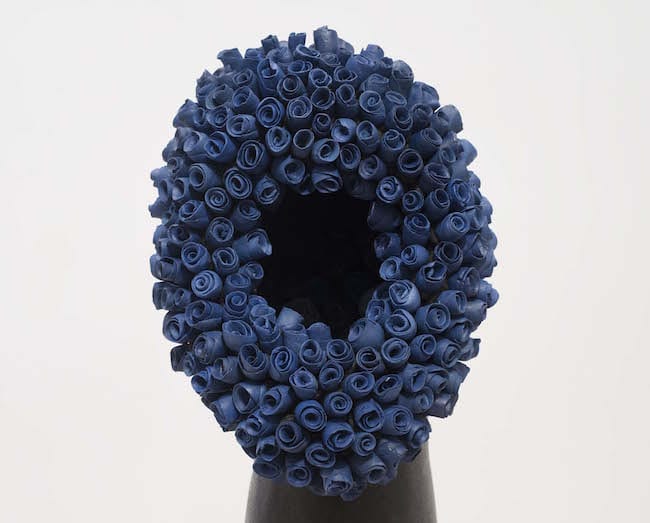Tilton Gallery presented Moulting, Simone Leigh’s second exhibition with the gallery (New York, March 3 – April 25, 2015) and as always with this artist the event provided layered commentary on race and gender with touches of humor for balance. Following her over the years has been worthwhile as she expands both the mediums of ceramics and multimedia sculpture. Early in her career she was an artist in residence at the Greenwich House Pottery.
Above image: Simone Leigh, No Face (cobalt)

Simone Leigh, Covered III (detail)
Simone Leigh’s show expands her exploration of ceramic-based and multimedia sculpture, filling the gallery with majestic, yet seemingly-vulnerable installations that celebrate the woman’s role in African and African American history. For about a decade she has been making manifest the role of women in object making as a vehicle to investigate questions of history, tradition, race and identity. Leigh’s current exhibition expands the possibilities in her approach to sculpture as performance.


Simone Liegh, Cowrie (Sage)
Ceramic glazed cowrie shells, formed from watermelon molds, often stand-alone works or combined in hanging installations, here become more direct stand-ins for the female body, and, as Leigh has written, for her “ongoing exploration of black female subjectivity.” These shells are perched on and are anchored by voluptuous fabric-covered cage-like armatures shaped like the bustles or “panniers” of 17th and 18th century hoop skirts. These refer at once to dresses worn across European and African and South American cultures — from Spain and Victorian England to the present day dress of the Herero in Namibia and other African countries, across the Caribbean, and in Brazil.
Writing in Bomb, Malik Gaines comments on the key role that these shells play in her symbolism.
“Despite the hauntedness of its reference and the aquatic ambivalence of its origin, the clay representation of the seashell is present and delicate, earthy and crafty, glazed and precious, really here. The cowrie form rhymes with human body parts—an eye, a vagina, a mouth, an anus—and asks psycho-sexual questions about looking, giving, receiving, being. These nodes of commodity exchange, symbolic language, and phenomenological embodiment constitute a triangle-trade of diasporic life—a kind of triple-sense-of-self described by Frantz Fanon—and while Leigh’s sculptures may be read as complete autonomous objects in the Euro-American modernist sense, an archipelago of subjectivity and imagination surrounds them.”
There is a nod to the colonization of African cultures, where African women adapt the Western European woman’s standard of dress that harks back to the dresses of American Southern mammies during slavery. Scale references a specific giant architectural sculpture, a pancake house entered through the figure’s skirt, in Mississippi.

Simone Leigh, Cowrie (Pannier)
As always, Leigh accesses multiple memories, while creating her own specific identities. A group of these “figures,” spread through one gallery, interact in a performative ways, like dancers in an open space. Down the hall, one similar, but larger structure, where the armature is exposed, resembles a hut more than a skirt, and can be entered by viewers.


Simone Leigh, “Moulting” installation view
Another gallery space is filled with women’s ceramic busts: heads with abstracted faces and formidable hair-dos fashioned out of Leigh’s signature ceramic, individually formed, rose petals. Each sculpture exhibits a proud personality from the position of the head, held high to their unique sculptured dos. Again, these silent, yet forceful women speak to each other across the room.

Simone Leigh, Herero Dress (Cobalt)


Simone Leigh, Bulawayo
Elsewhere a belt with hanging black ceramic banana-shaped objects recreates Josephine Baker’s skirt. And a totem pole topped by a large cowrie shell covered in gold leaf stands tall, like a tree of life, but also taking on the stature of a regal standing figure.


Simone Leigh, Skirt
Throughout her work, Leigh evokes the history of ideas, ethnographic memories and postcolonial legacies through form and symbolism, transforming sociopolitical content into poetic semi-abstract contemporary sculptures that speak very much to the present.


Simone Leigh, Invisible Manish
The artist states in Artforum:
“I’ve also started making jugs with Lizella clay, one of which will be in my show at Tilton Gallery. I’ve been told that African-American face jugs are made to look ugly to ward off evil spirits. Using the ugly, sometimes literally taking on the garment of your oppressors, is a device used often in the global south.”

Simone Leigh, Jug
In this case the jug is not about the face, it’s not voodoo in any way. Rather, the furious patina of finger marks speaks to me of intense labor. Until the Emancipation, most Southern pottery was the product of slaves. Skilled potters were a prized commodity, a profit center to use present day corporate jargon, fetching high prices at auction. (One might want to read our post on Dave the Slave in this regard).

Born in Chicago to Jamaican parents, Simone Leigh has shown at museums including the Contemporary Art Museum, Houston, the Studio Museum in Harlem, where she was an artist in Residence in 2010- 2011, and the Atlanta Contemporary Art Center, where she recently completed her first one person museum exhibition. She is a recipient of the Louis Comfort Tiffany Foundation Biennial Award, the Joan Mitchell Foundation Award, and the Creative Capital Grant, among others. She participated in the 2011 Biennial of Contemporary African Art in Dakar, Senegal and has lectured widely at Universities such as Columbia and NYU. Leigh lives and works in Brooklyn, New York.
Garth Clark is the Chief Editor of CFile.
Any thoughts about this post? Share yours in the comment box below.

Simone Leigh

A very talented young artist. Kudos to her!